Michigan hop crop report week of June 29, 2023
Much needed rain has brought drought relief to Michigan hopyards over the past week.

Weekly weather review
Over the last week, temperatures across the state were greater than normal. Most locations in the Lower Peninsula received some much-welcomed precipitation last weekend through June 29.
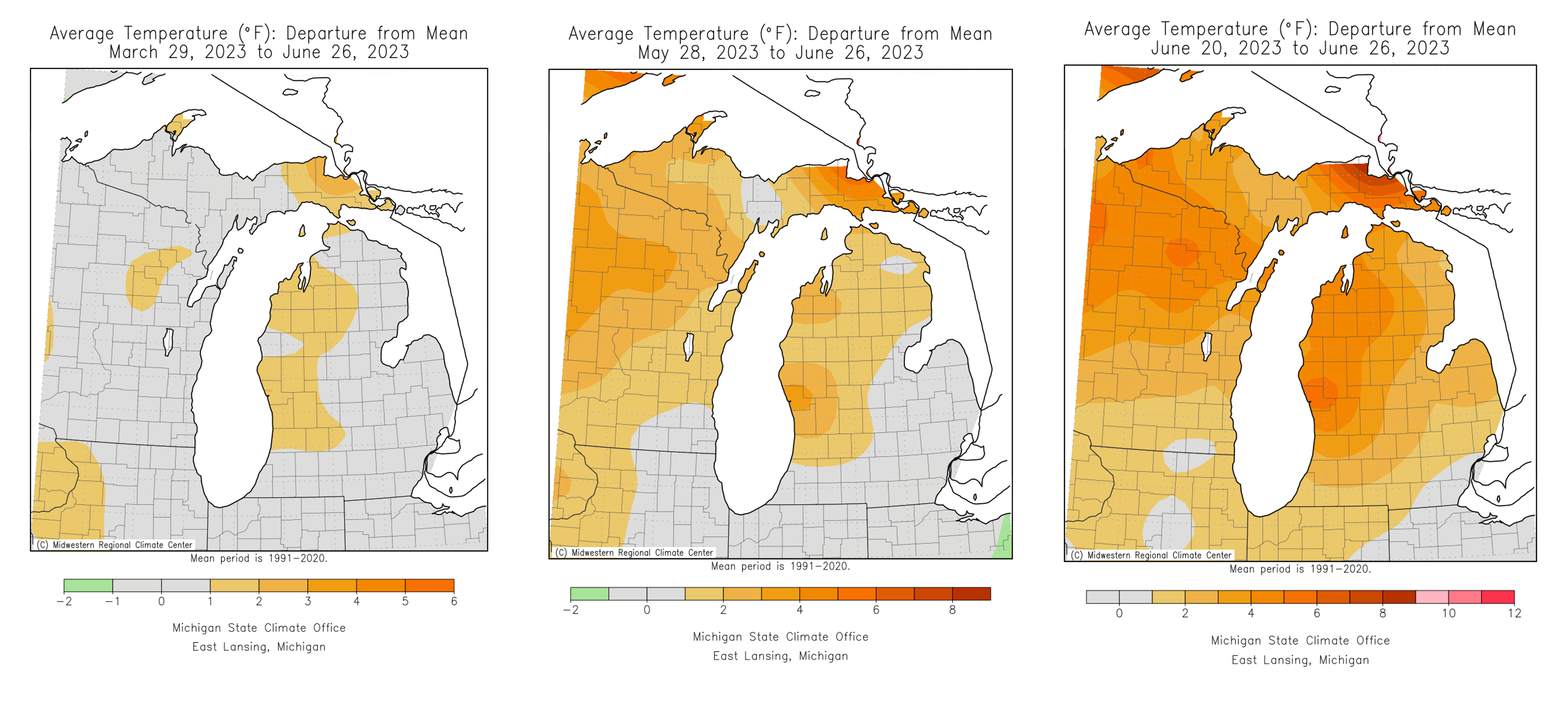
Despite the recent precipitation, it is still abnormally dry across the state, with most of the Lower Peninsula in moderate drought status. Areas in central and south-central Michigan are experiencing severe drought.
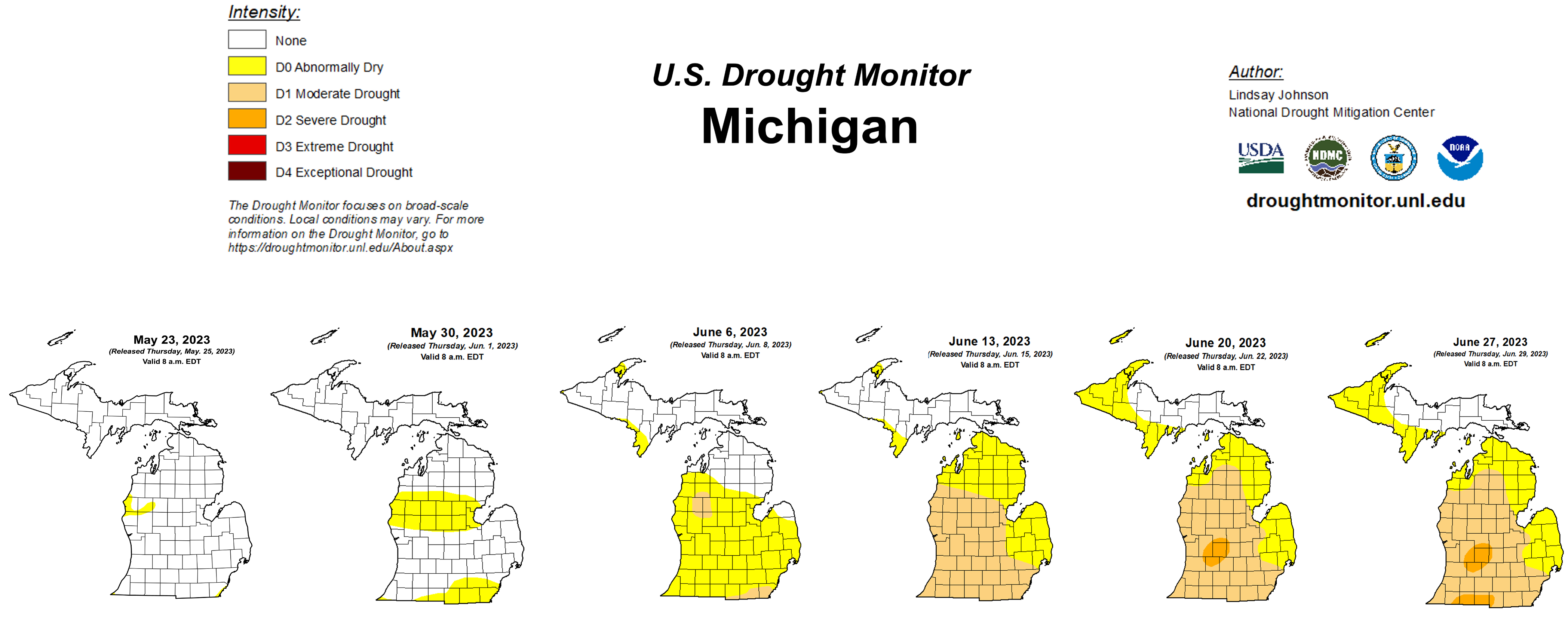
Looking ahead
NOAAs 6-10 Day Outlook suggests above average temperatures as well as above average precipitation.
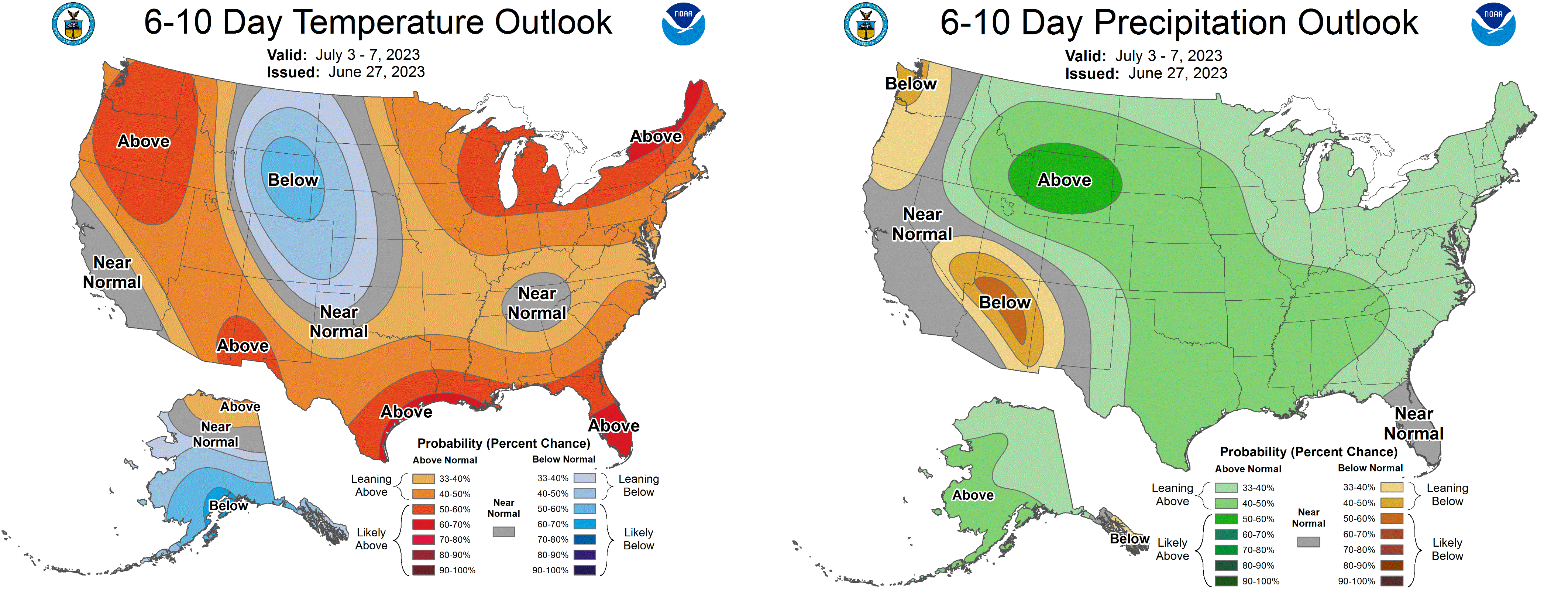
View the most recent MSU agriculture weather forecast.
Stage of production/physiology
Hops across Michigan are in Principal Growth Stage 1: Leaf Development, Growth Stage 2: Formation of Side Shoots, 3: Elongation of Bines, and 4: Inflorescence emergence depending upon growing location.
In the field
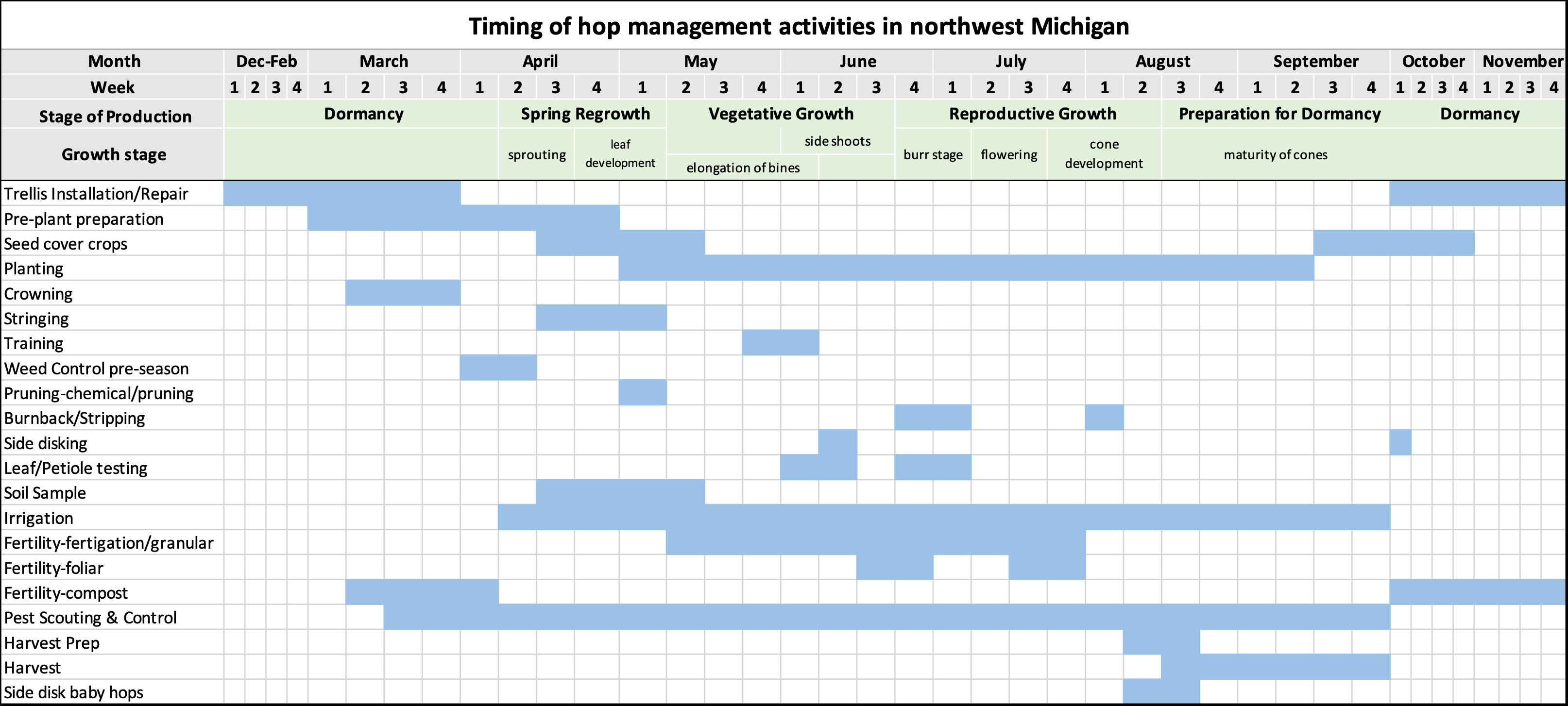
Plants are nearing 14-18 feet in southern Michigan and 8-14 feet in northern Michigan hop growing regions. Growers are actively watering and managing growth through application of fertilizer. Plant protection products are being applied to prevent pest issues.
Weeds
Grass weeds need to be treated when small for optimal control. Spot treatments for tough weeds like Canada thistle may be needed. Refer to the Michigan Hop Management Guide for weed control options. For additional information on weed control in hopyards, check out the presentation Weed Management in Hops by Rick Boydston of the USDA Agricultural Research Service.
Diseases
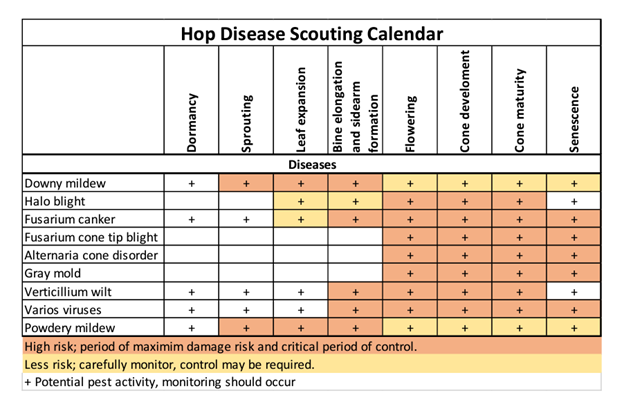
As we move towards burr stage (i.e., bloom), growers should be planning for several critical fungicide applications to protect cones from multiple diseases, including downy mildew, powdery mildew, halo blight and associated secondary cone diseases.
Downy mildew
Downy mildew infection symptoms are visible in some yards. Downy mildew is caused by the fungus-like organism Pseudoperonospora humuli. It is a significant disease of hop in Michigan, potentially causing substantial yield and quality losses. This disease affects cones and foliage and can become systemic; in extreme cases, the crown may die. Cool and damp weather during the spring provide ideal growth conditions for the pathogen.
Disease severity is dependent on cultivar, environmental conditions and management programs. Focus on proactive management strategies, including 1) sourcing clean planting stock, 2) clean crown management in the spring, 3) scouting regularly and 4) utilizing a preventative fungicide program.
Unfortunately, even when best management practices are followed, downy mildew can gain a foothold in Michigan yards due to high disease pressure, challenges with fungicide application timing, suboptimal spray coverage, fungicide wash-off, cultivar susceptibility or a combination of these factors. In addition, fungicide resistance and infected nursery plants may play a role in some disease control failures.
Downy mildew fungicide treatments must be applied on a protectant basis as soon as bines reach 6 inches in the spring (regardless of the presence or absence of visible symptoms of downy). If growers are planning to remove the first flush of growth by pruning, the first fungicide application should occur only after regrowth. Applications should continue season long on a seven- to 10-day reapplication interval. The time between applications may stretch longer when the disease pressure is low, particularly after cone closure. Several periods in the season are particularly critical for disease control: immediately before and after training; when lateral branches begin to develop; bloom; and when cones are closing up.
Covering young, developing bracts before cones close up is critical to protecting against downy mildew when conditions for disease are favorable. Getting adequate coverage on undersides of bracts where infection occurs becomes increasingly difficult as cones mature.
Refer to the Michigan Hop Management Guide’s section on downy mildew for additional management information, including fungicide options. For more information on pruning, refer to the Michigan State University Extension article, “Pruning hops for disease management and yield benefits."
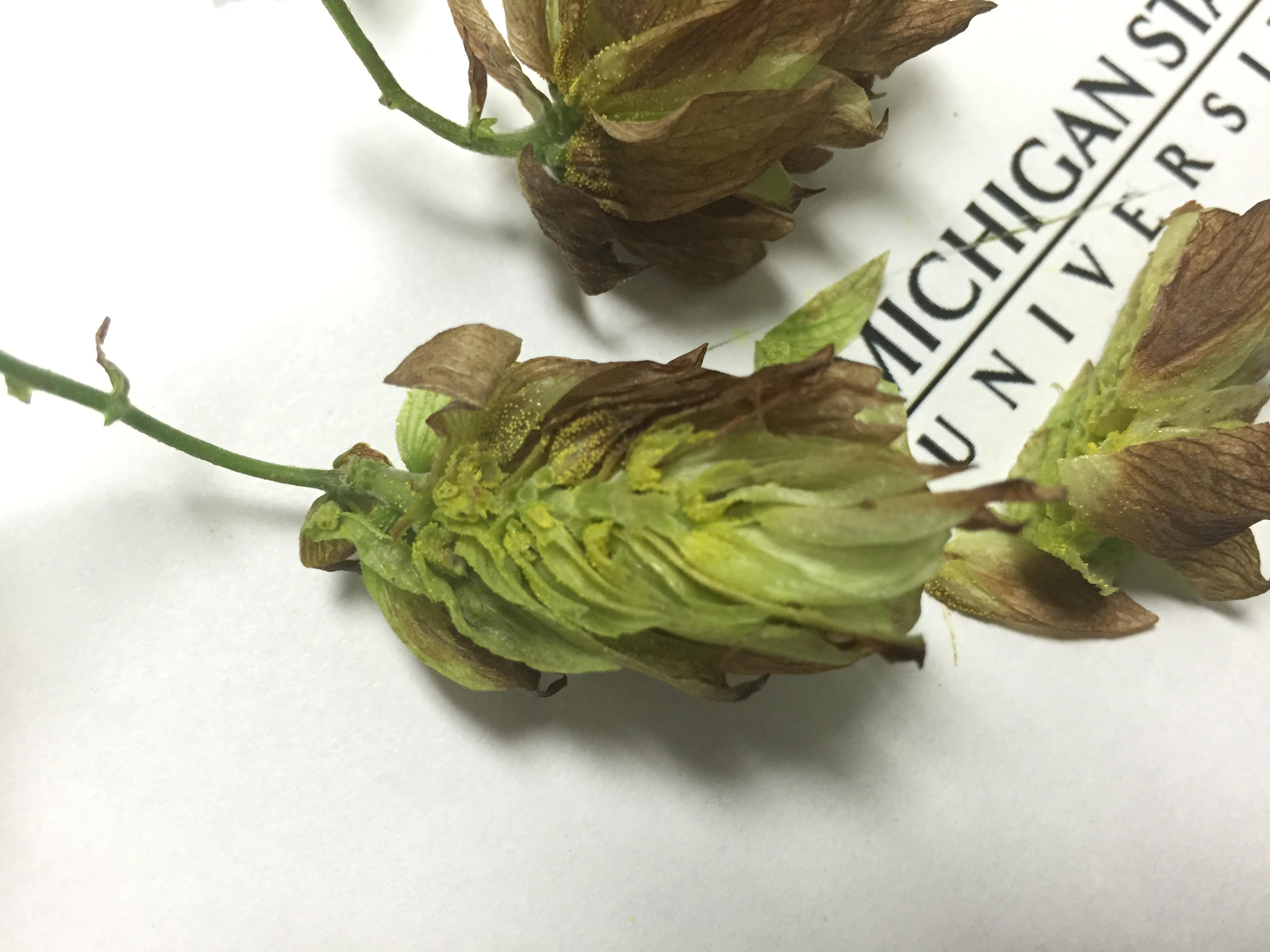
Powdery mildew
In addition to downy mildew, growers should also be vigilant in scouting for and managing powdery mildew, which may be a bigger issue this year with early hot and dry conditions. Powdery mildew of hop (caused by the fungus Podosphaera macularis) is an important but sporadic disease in Michigan hopyards. Seasonal powdery mildew disease severity is dependent on cultivar, environmental conditions and management programs. Focus on proactive management strategies, including sourcing clean planting stock, scouting regularly and utilizing a preventative fungicide management program.
Powdery mildew resulting from bud infection appears in the spring white stunted shoots called “flag shoots.” Flag shoots are rare, accounting for less than 1% of all shoots in a field and making detection at this stage very difficult. Secondary lesions become visible as leaf tissue expands and first appear as raised blisters, which quickly develop into white, round colonies. Infected burrs and cones can also support white fungal colonies or may exhibit a reddish discoloration if infected later in development.
Burrs and young cones are very susceptible to infection, which can lead to cone distortion, substantial yield reduction, diminished alpha-acids content, color defects, premature ripening, off-aromas and complete crop loss. Cones become somewhat less susceptible to powdery mildew with maturity, although they never become fully immune to the disease. Infection during the later stages of cone development can lead to browning and hastened maturity. Alpha-acids typically are not influenced greatly by late-season infections, but yield can be reduced by 20% or more due to shattering of overly dry cones during harvest resulting from accelerated maturity.
Conditions that favor powdery mildew are reported to include low light levels resulting from cloud cover, canopy density, excessive fertility and high soil moisture. Leaf wetness from dew or rain does not directly impact powdery mildew infection, but results from high humidity and cloud cover, which favors disease. Temperatures from 46 to 82 degrees Fahrenheit allow powdery mildew to develop, but disease is favored by temperatures of 64 to 70 F; disease risk decreases when temperatures consistently exceed 86 F for six hours or more.
Regular fungicide applications are needed to prevent infection and are applied regardless of visible symptoms. Appropriate timing of the first fungicide application after pruning is important to keep disease pressure at manageable levels. This application should be made as soon as possible after shoots reach 6-10 inches or regrow in pruned yards. For a complete listing of recommended fungicides and additional information, refer to the MSU Extension article, "Managing hop powdery mildew in Michigan."
Fungicide applications alone are not sufficient to manage the disease. Under high disease pressure, mid-season removal of diseased basal foliage delays disease development on leaves and cones by lowering inoculum and increasing airflow. Do not apply desiccant herbicides until bines have grown far enough up the string so that the growing tip will not be damaged, and bine bark has developed. In trials in Washington, removing basal foliage three times with a desiccant herbicide (e.g., carfentrazone-ethyl) provided more control of powdery mildew than removing it once or twice.
Established yards can tolerate some removal of basal foliage without reducing yield. This practice is not advisable in baby plantings (less than 3 years) and may need to be considered cautiously in some situations with sensitive varieties such as Willamette. The potential for quality defects and yield loss increases with later harvests when powdery mildew is present on cones.
Diaporthe
It is also important to note that the fungicides applied for powdery mildew control in FRAC groups 3, 7 and 11 have been shown in preliminary research to be effective against Diaporthe, a relatively new disease to Michigan growers. You can read more about this disease and university efforts to address it in the MSU Today article, Finding and fighting a new hop disease in Michigan. Growers struggling with this issue may contact Erin Lizotte at taylo548@msu.edu for assistance.
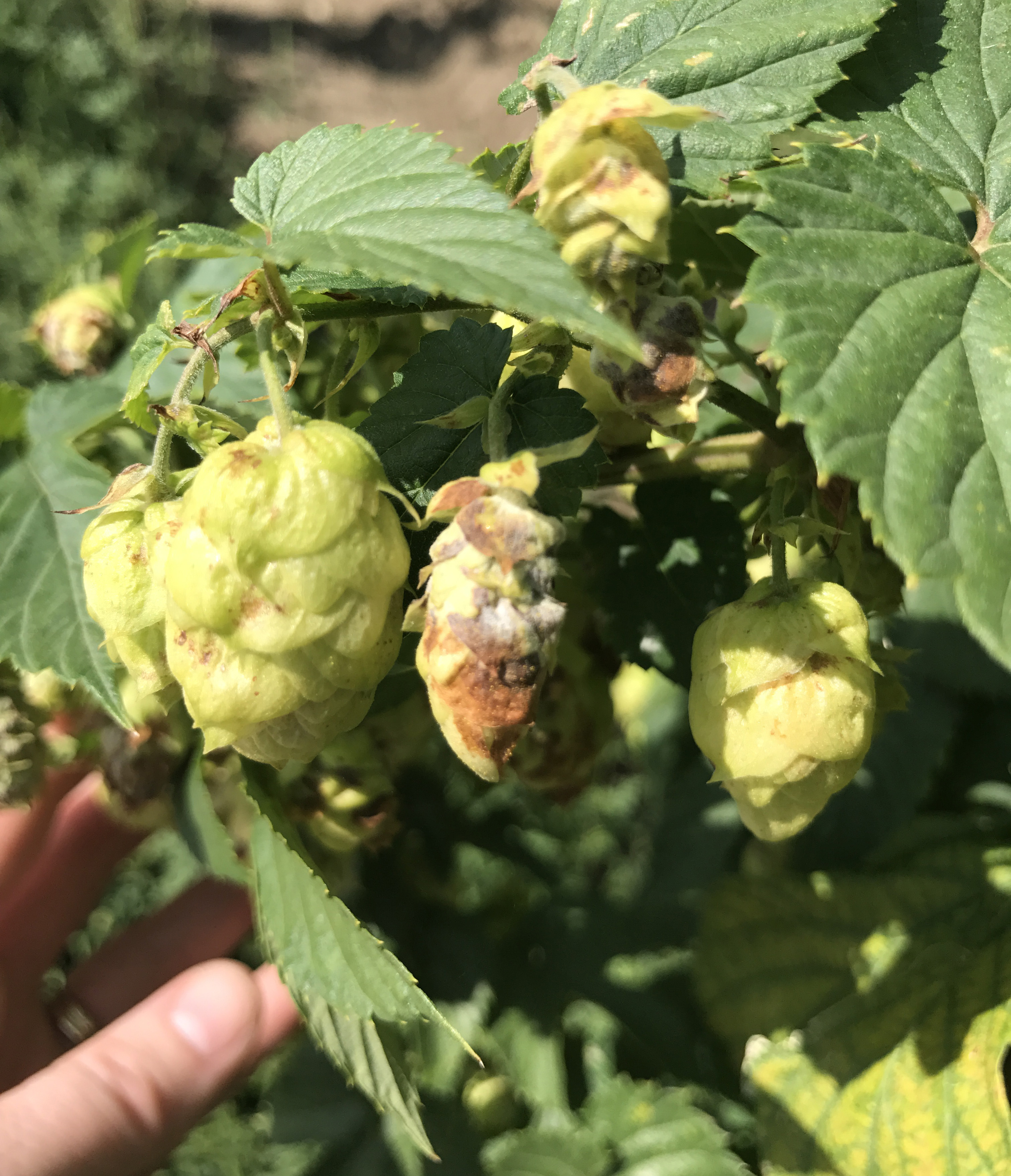
Virus
Symptoms of suspected viral expression are being reported. Hops are known to host several viruses and viroids that potentially impact profitability by reducing yield, quality and/or plant longevity. Several of these pathogens are widespread in Michigan and mixed infections of multiple viruses and viroids in a single plant are frequently found. The perennial nature of hops and common methods of propagation contribute to the accumulation of viruses over time.
Accurately diagnosing a viral infection can help growers in making long and short-term management decisions on the farm. For information on virus testing available through Michigan State University, check out the publication Viruses of Hop in Michigan.
Insects
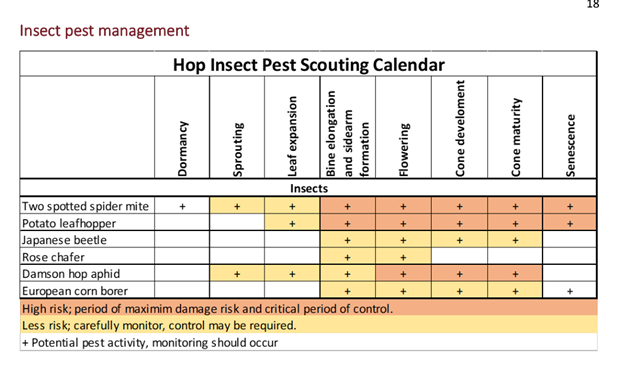
European corn borer
First generation adult flight of European corn borer is continuing throughout much of the Lower Peninsula with a few warmer regions predicting the end of first-generation flight. To estimate adult flight in your region, refer to the Enviroweather European Corn Borer Model. European corn borer overwinters as larvae inside the host plant where it pupates (matures) in response to warming temperatures in spring. First generation flight of moths occurs from 450 to 950 GDD base 50, based on a March 1 start date for GDD accumulation. Currently, GDD50 accumulation in the Lower Peninsula ranges from 660-1,028. The second generation of European corn borer generally emerges around 1,450 GDD50. Continue scouting for adults, eggs and larvae to confirm model forecasts and make accurate management decisions.
Egg development is driven primarily by temperature, but generally eggs hatch in approximately 12 days. Newly hatched larvae then feed externally on leaves for approximately seven days before boring into stems and petioles where they continue to feed and grow. Once inside the plant, observations in hop indicate that European corn borer larvae damage vascular tissue, disrupt the flow of nutrients and water and impede plant development.
In hop, European corn borer larvae can be found in leaf petioles, sidearms, cone petioles (strigs) and bines. Their location and prevalence in the plant dictates the severity of damage. The most severe damage observed in Michigan hops occurs when hopyards are infested by first generation flight in June during bine elongation and subsequent sidearm and cone development stages. This early infestation greatly reduces yield and leads to variable cone maturity dates.
Focus on scouting for adult moths and eggs to allow for corrective management before larvae enter the bine. European corn borer eggs are smaller than the head of a pin but are laid in visible groupings. Eggs are white when first laid but change to yellow and then develop a black spot (the larval head capsule) just before hatching. Eggs are likely deposited on the underside of hop leaves in masses of 20 to 30 and covered with a waxy film. If available, you may have better luck spotting eggs in adjacent corn fields.
European corn borer larvae are light gray to faint pink caterpillars with a dark head and have dark spots along the sides of each segment and a pale stripe along the back. They grow to about 1 inch but start out very small at hatch and feed briefly on leaf tissue before boring into hop bines, and even hop leaf petioles.
European corn borer pupae are smooth, reddish brown, cylindrical and about a half-inch long and found inside bines.
The European corn borer moth is about 1 inch long and light brown with wavy bands across the wings. The male is slightly smaller and darker. The tip of the body protrudes beyond the wings. Adult moths are most active in grassy areas before dawn.
Small European corn borer larvae are the intended target of insecticides, so monitoring for adult moth flight is critical to predicting the start of egg laying and the subsequent window of egg hatch.
For more information on European corn borer management, refer to the Michigan State University Extension article, “Be on the lookout for European corn borer in hops."

Potato leafhopper
Growers should be on the lookout for potato leafhopper. Like many plants, hops are sensitive to the saliva of potato leafhopper, which is injected by the insect while feeding. Damage to leaf tissue can reduce photosynthesis, which can impact production, quality and cause death in baby plants. To learn more about potato leafhopper, refer to the Hop Potato Leafhopper Factsheet
Twospotted spider mite
Mite pressure has been high in May and June, due in part to hot dry conditions across much of the state. Growers should carefully monitor for twospotted spider mites. Twospotted spider mite is a significant pest of hop in Michigan and can cause complete economic crop loss when high numbers occur. Feeding decreases the photosynthetic ability of the leaves and causes direct mechanical damage to the hop cones. Leaves take on a bronzed and white appearance and can defoliate under high pressure. Intense infestations weaken plants, reducing yield and quality. Dry, hot weather provides ideal conditions for outbreaks. Scout carefully for mites season-long and treat while populations are at low levels, when mites are most effectively managed.
Refer to the twospotted spider mite factsheet for more information on identification and management.
Rose chafer
Adult rose chafer activity continues. Rose chafers are considered a generalist pest and affect many crops, particularly those found on or near sandy soils or grassy areas conducive to grub development. The adult beetles feed heavily on foliage and blossom parts of numerous horticultural crops and can cause significant damage to hop plants, particularly young plants with limited leaf area. Rose chafer skeletonize leaf tissue, giving them a fine lace-like appearance.
Rose chafer cause simple mechanical damage, so consider that established plants can sustain a significant amount of leaf feeding from rose chafer with no negative implications to the plant or crop. Young plants with limited leaf area may require more aggressive management. Chafer activity has typically subsided by the time burrs are present, so yield reductions are not an issue. For more information, refer to the Rose Chafer Factsheet.
Stay connected!
Sincere thanks to the Michigan hop producers who provided timely input for the Michigan hop crop report.
For more information on hop production practices, please sign up for the MSU Extension Hop & Barley Production Newsletter, the free MSU Hop Chat Series and continue to visit Michigan State University Extension’s Hops website or the MSU Hops News Facebook.
If you are unsure of what is causing symptoms in the field, you can submit a sample to MSU Plant & Pest Diagnostics. Visit the webpage for specific information about how to collect, package, ship and image plant samples for diagnosis. If you have any doubt about what or how to collect a good sample, please contact the lab at 517-432-0988 or pestid@msu.edu.
Become a licensed pesticide applicator
All growers utilizing pesticide can benefit from getting their license, even if not legally required. Understanding pesticides and the associated regulations can help growers protect themselves, others, and the environment. Michigan pesticide applicator licenses are administered by the Michigan Department of Agriculture and Rural Development. You can read all about the process by visiting the Pesticide FAQ webpage. Michigan State University offers a number of resources to assist people pursuing their license, including an online study/continuing educational course and study manuals.
This work is supported by the Crop Protection and Pest Management Program [grant no 2021- 70006-35450] from the USDA National Institute of Food and Agriculture and the North Central IPM Center. Any opinions, findings, conclusions or recommendations expressed in this publication are those of the author(s) and do not necessarily reflect the view of the U.S. Department of Agriculture.



 Print
Print Email
Email